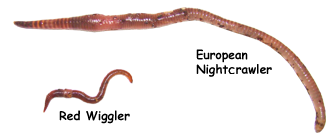Red Wiggler Worms - Natural Solution for Environment-friendly Composting
Red Wiggler Worms - Natural Solution for Environment-friendly Composting
Blog Article
Red Wiggler Worms Demystified: Unlocking the Tricks of Vermiculture for Greener Living and Nutrient-Rich Soil
In the world of sustainable techniques for improving soil quality and promoting eco-conscious living, red wiggler worms play an essential yet frequently forgotten function. Red Wiggler Worms. Comprehending the details of caring for these worms, maximizing their environment, and harnessing their spreadings can lead to a greener lifestyle and healthier soil for plants to flourish.
The Function of Red Wiggler Worms
Red Wiggler worms play a crucial role in composting systems by efficiently damaging down raw material into nutrient-rich spreadings. These starved eaters take in a selection of natural materials, such as cooking area scraps, backyard waste, and paper items. As they feed, the worms' digestive procedures break down the raw material right into a fine, dark, and nutrient-dense product called worm spreadings or vermicompost.
The spreadings produced by Red Wiggler worms are very helpful for soil wellness and plant development. They are rich in crucial nutrients like potassium, nitrogen, and phosphorus, which are vital for supporting healthy and balanced plant growth. In addition, worm castings include beneficial microbes and enzymes that assist boost soil framework, increase water retention, and boost nutrient uptake by plants.
Benefits of Vermicomposting

In addition, vermicompost, the nutrient-rich final product of vermicomposting, functions as an exceptional organic fertilizer and soil conditioner. It boosts soil structure, enhances soil oygenation, and boosts dirt dampness retention. These homes add to much healthier plants with stronger origin systems and better resistance to parasites and illness. Vermicompost also improves the soil with necessary nutrients like nitrogen, phosphorus, and potassium, advertising plant growth and total dirt fertility.
In addition, vermicomposting assistances lasting horticulture practices by providing a natural and chemical-free alternative to synthetic fertilizers. Red Wiggler Worms. This eco-friendly strategy not only enhances the dirt yet additionally helps in reducing dependence on damaging chemicals, advertising a greener and more lasting means of horticulture
Establishing a Worm Bin
When developing a worm bin for vermicomposting, appropriate arrangement is vital to guarantee the success of the composting process. The first action in establishing up a worm container is selecting an ideal container.
After adding the bed linen, introduce the red wiggler worms to the container. It is recommended to begin with a small number of worms and gradually raise as they multiply. The worms ought to after that be offered with food scraps such as fruit and vegetable peels, coffee premises, and eggshells. It is vital to avoid adding meat, dairy, oily, or salted foods to stop bring in bugs and producing undesirable odors.
On a regular basis keep an eye on the moisture degrees and temperature level in the worm bin to ensure ideal conditions for the worms. With appropriate setup and maintenance, the worm container will efficiently transform organic waste right into nutrient-rich garden compost for your plants and yard.
Gathering Worm Spreadings
To efficiently gather nutrient-rich worm castings from your vermicomposting system, an organized harvesting method is necessary. When it comes time to collect the worm castings, there are a few crucial Get More Info actions to comply with to make certain a successful process.

Troubleshooting Common Issues
Determining and dealing with usual difficulties that may emerge throughout the vermicomposting process is critical for preserving a healthy and efficient worm bin. Including excess food scraps can lead to a buildup of dampness and acidity in the worm container, potentially damaging the worms. Another concern is unpleasant smells emanating from the worm container.
Furthermore, if the worm populace is declining or the published here worms show up undesirable, it could be because of environmental stress factors such as extreme temperatures or pH levels. Keeping track of these factors and making needed adjustments is vital for the health of the worms. By troubleshooting these typical concerns quickly, vermicomposters can make sure a successful and smooth vermicomposting process while keeping a thriving worm population.

Conclusion
In conclusion, red wiggler worms play an important role in vermiculture by breaking down natural matter into nutrient-rich dirt. Establishing up a worm bin is necessary for successful vermiculture, and harvesting worm spreadings supplies important compost for horticulture.
As they feed, the worms' digestion processes damage down the natural matter right into a fine, dark, and nutrient-dense material recognized as worm castings or vermicompost.
The spreadings created by Red Wiggler worms are highly advantageous for dirt health and wellness and plant growth. Including excess food scraps can lead to an accumulation of moisture and level of acidity in the worm bin, possibly harming the worms.Additionally, if the worm populace is decreasing or the worms appear harmful, it can be due to environmental stress factors such as severe temperatures or pH levels. Establishing up a worm container is essential for effective vermiculture, and harvesting worm spreadings offers beneficial compost for horticulture.
Report this page